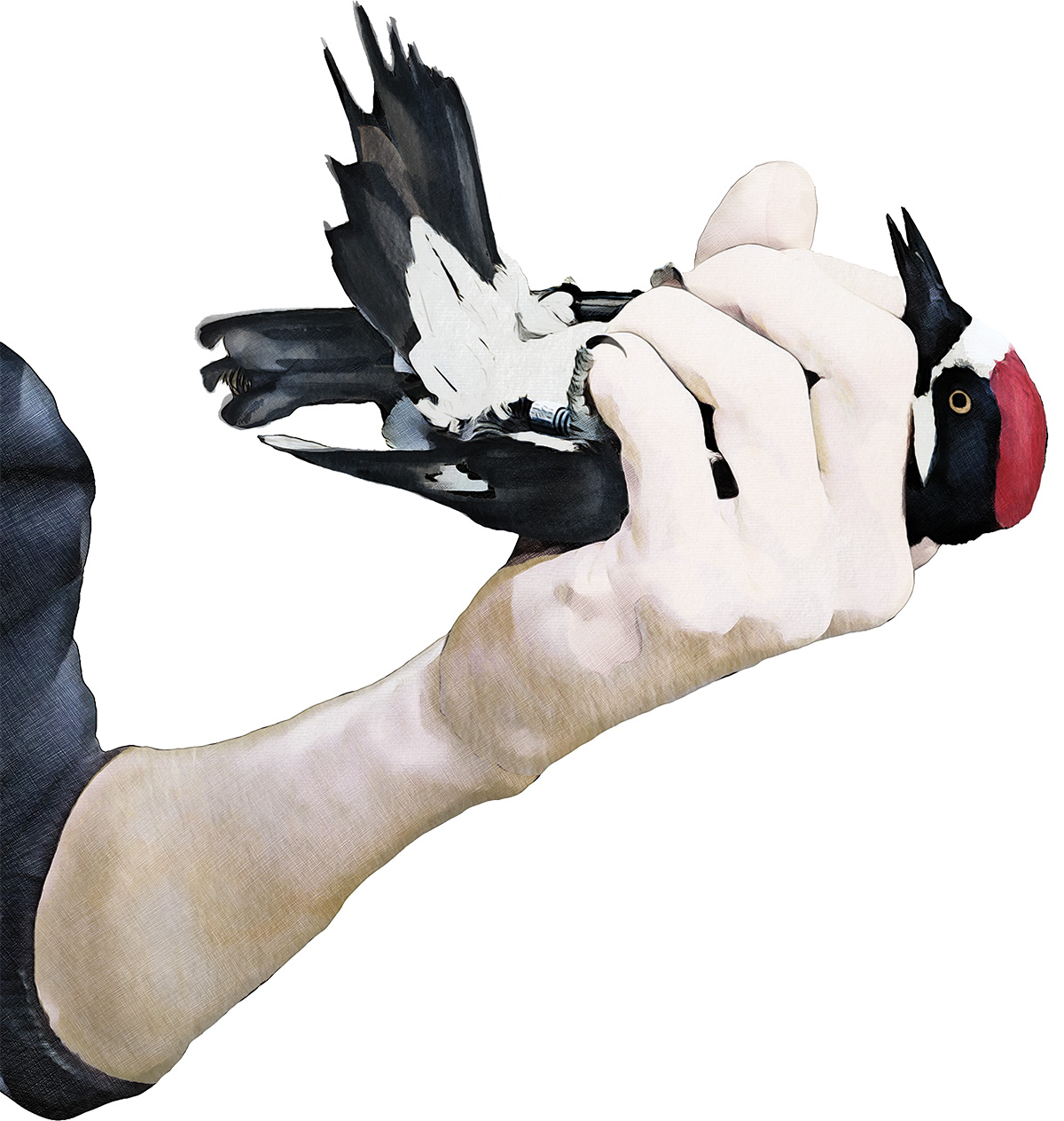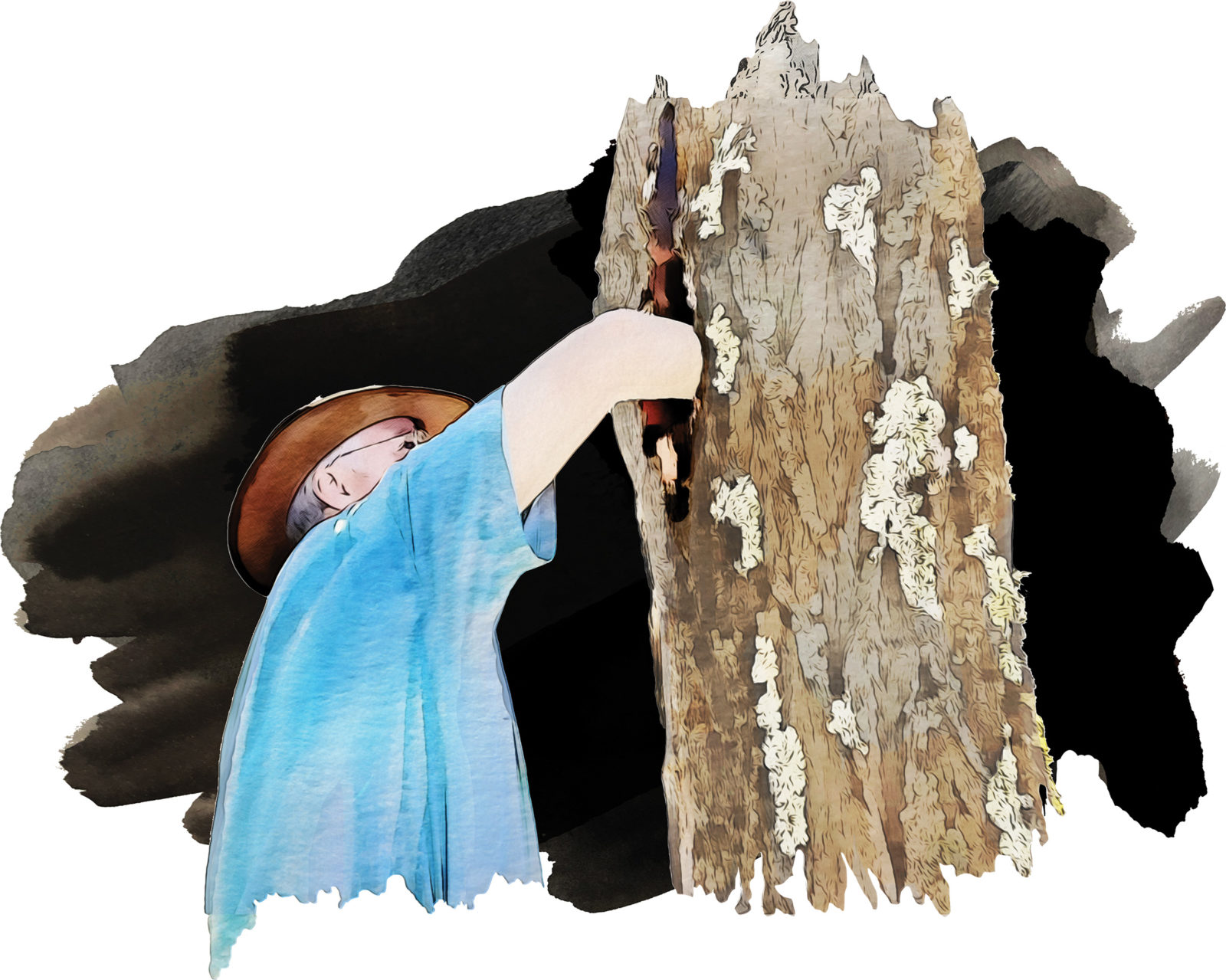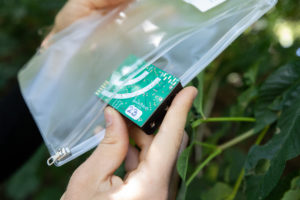ACT I: The Ambush
“Tis now the very witching time of night”
If you want to catch an acorn woodpecker, you’ll probably have to climb a tree at night while the woodpeckers are roosting in tree cavities. You’ll definitely have to shove your arm into that cavity without being able to look inside. If you’re unlucky, there could be a gopher snake in there. It might have beaten you to the woodpeckers, and you’ll pull out a well-fed snake instead of a bird. But one morning in June, biologist Russell Winter is hoping to get lucky. It’s still dark out at 4 a.m. and he’s dangling from a rope halfway up a 45-foot-high oak tree. He’s about to stick his arm into a tree hole, almost up to his elbow, to fish out an adult woodpecker.
Winter planned the ambush yesterday. First, he assembled the ambusher, a low-tech contraption consisting of fishing line and a bobber. The round bobber is just slightly bigger than the entrance hole to an acorn woodpecker’s cavity and prevents the birds’ escape. Then he staked out the birds until nightfall to make sure that they’d entered the cavity. Early this morning, while the great horned owls were still hooting, he returned in the dark. He pulled on the fishing line until the bobber slipped into the hole, trapping the birds inside. He ascended by rope until he was within reach of the cavity. Now, steadying himself against the tree trunk with his legs—like a woodpecker using its tail—he sticks his arm into the cavity and removes two birds, one after the other. He places each bird in a cloth drawstring bag, puts the bags in his backpack, and rappels to the ground.
While he was up in the tree, his assistants, Hannah Horowitz and Megan Massa, created a makeshift workstation by spreading a blanket on the forest floor. Sitting cross-legged next to the blanket, Winter takes a bird out of the drawstring bag. Holding it firmly but carefully, he measures the bird and then fastens four tiny bands around its legs in a distinct color pattern. Lastly, he ties to the woodpecker’s back a tiny computer chip that will transmit a unique code picked up by one of 50 base stations every time the bird flies overhead.
For more than 50 years, biologists have been researching acorn woodpeckers here at the Hastings Natural History Reservation, a UC Berkeley field station in the oaken hills of Carmel Valley, in one of the longest-running bird studies in North America. It’s common for scientists to use color bands to track and study birds. But here at Hastings, it’s especially important. “An unbanded adult woodpecker is useless to the data set,” Winter says.
The scientists here study the social interactions of these birds and need to be able to recognize each individual. Acorn woodpeckers have one of the most complex social structures of any animal. They’re cooperative breeders, meaning that multiple female and male birds live together in one group, breeding with each other and laying eggs in the same nest. The offspring often stay with the group and help raise their parents’ young. But as Eric Walters, principal investigator for the Hastings woodpecker research, says, “Cooperative doesn’t always mean they don’t have conflict.” When the last breeding female or male in one group dies, other birds fly in from miles away to become the new breeder. It’s a bit like a Shakespearean tragedy, with numerous contenders fighting for the throne once the king has passed on.
Winter hands the banded woodpecker to Horowitz. She cups the animal in her hands and brings it close to her face. “Feed your children!” she admonishes, and then stretches out her arms and releases. The woodpecker flies into the oak trees, out of sight.

ACT II: “Waka waka”
“Brevity is the soul of wit”
With their round white eyes and conical beaks, acorn woodpeckers provide the comic relief of the oak woodlands. On hikes, you might hear their raucous “waka waka” calls and look up to see multiple woodpeckers flying out of a tree hole, like clowns tumbling out of a clown car.
Generations of scientists have studied the birds at UC Berkeley’s Hastings Reserve. Researchers Michael and Barbara MacRoberts launched the project in 1968 to learn more about the birds’ complex social structures. In 1974, Walt Koenig arrived and has more or less been here ever since. Now technically retired, he lives down the road from the reserve and comes by almost every day. He has a nasally Midwestern accent reminiscent of a woodpecker’s “waka” call. When he arrives at the office, he greets Walters with a “waka.” Walters, who took over as project lead in 2016, answers “waka” back. When Walters first welcomed Winter, Horowitz, and others to the crew, he signed off his email with a “waka.” One crew member told me that she didn’t know what it meant so she googled it. She learned it was a Maori word, but she was pretty sure that’s not what he meant.

ACT III: It’s not all love and hippies
“A little more than kin and less than kind”
It’s a more reasonable hour now. Almost noon. Horowitz sits in a camping chair inside a pop-up blind, a tiny, camouflage-brown tent big enough only for her, a spotting scope, and a clipboard of data sheets. She watches the woodpeckers through her scope as they fly in and out of a hole in a large sycamore tree.
Acorn woodpeckers live in strictly defined groups, each with its own territory. Here at Hastings, each territory averages 14 acres in size. Horowitz can see five different social groups from her blind. Up the hill lives the group called “MacRoberts.” Behind her lives the group “Cavity.” At the “Y” road junction to the left lives a group called “Y.” To the right, in locust trees by an old barn, lives group “Knoll.” A group’s territory includes one or more trees with holes for roosting and nesting, and a “granary” where acorn woodpeckers store their acorns. Unlike other woodpeckers that forage for bugs in wood, acorn woodpeckers acrobatically catch insects in the air. They store acorns as backup for those days when there are no insects.
They eat all kinds of acorns, storing them in thick bark or any soft, dead wood they can find—the bark of a blue oak; a dead limb in a coast live oak; or, to the chagrin of PG&E, a utility pole. As the acorns dry out and shrink, the woodpeckers move them to smaller holes so that other animals can’t steal them. Unlike California scrub jays whose acorn caching helps oaks spread, acorn woodpecker granaries don’t contribute to trees’ reproduction, as far as scientists know. But the birds also don’t seem to harm the trees.
Walters says it takes 20 minutes for a woodpecker to make one granary hole, and a woodpecker group needs at least a thousand holes to survive. “You can do the math,” he says. “To make a granary is not a simple task.” One individual couldn’t make a granary on its own, which is probably why acorn woodpeckers live and work together in large family groups. Cooperative breeding tends to occur among animals in harsh environments, says Walters, where working together confers a clear survival advantage. California’s acorn woodpeckers don’t live in a harsh environment, but they do live in a variable one. Since the acorn crop can vary dramatically from year to year, the birds must store them for lean times.
The group Horowitz is watching, called “Why Knoll,” is new. (Its name comes from its location between the “Y” and “Knoll” groups.) A few woodpeckers from “Knoll” seem to be moving here to claim territory. Horowitz is trying to figure out who they are. “It’s like detective work,” she says.
She shows me a three-ring binder. “This book here is kind of our Holy Grail,” she says. It lists all the banded woodpeckers currently living in the reserve, notes each individual’s unique four-color-band pattern, and organizes every bird by group. It’s a combination phone book and family tree, and it’s updated constantly. Horowitz can look at a bird, note its band colors, and usually determine its group of origin by consulting the binder.
“Here’s a good example of how much the group size can vary,” she says, pointing in the binder to a group called “Pipeline.” It has only three woodpeckers, two females and a male. By contrast, the group called “Gate” takes up two pages and contains 16 birds!
What makes a group? It’s complicated. A group can have multiple males that are related to each other (some mix of brothers, fathers, sons, uncles, or nephews), all mating with multiple females that are related to each other (sisters, mothers, daughters, aunts, or nieces). The adult children, called “helpers,” often stick around and assist in raising the young, who could be their siblings or cousins.
Take the “Gate” group: with 16 members, it contains four “breeder” males, one “breeder” female, two female and five male helpers, and four new offspring from this year.
Scientists may call this cooperative breeding, but don’t be fooled. “People always think it’s all love and happy and the hippies—1960s,” says Walters. But if this is a utopia, it’s one that’s strictly regimented and rife with complicated rivalries. Males fight over the group’s females. Female breeders sometimes toss each other’s eggs out of the nest. And then come the power struggles. When the last breeding male or female dies, helper birds from other groups compete to inherit the vacated breeder spot.
Or a bird can ascend to breeder status from within the group. “Say there’s a bunch of helper males and their father’s the breeder,” Walters says. If the breeding female dies, a new female will enter the group. The helper males who couldn’t breed with their mother “now ascend,” Walters says. “They become co-breeders with their dad now because their mother is dead and this new female is not related to them.”
Confused? Well, the woodpeckers aren’t. Acorn woodpeckers have what’s called triadic awareness: one individual can recognize and understand the relationship between two other individuals. This holds for relationships within the group and outside the group. Biologists think the young birds learn who their brothers and sisters are by remembering who is in the nest with them and identify their parents and adult siblings by noting who feeds them. Adult siblings come to know the family’s newest additions as they bring them food. And they learn about the relationships in other groups by watching how those families interact. It’s like being able to recognize not just your neighbor, Walters says, but also your neighbor’s son who has come home for a visit and a stranger who has shown up at your neighbor’s doorstep.
Triadic awareness hasn’t been documented in any other wild bird. Other birds may have the ability, but we wouldn’t know because it’s so difficult to study in the wild. The trait has been observed in captive ravens and primates—animals known for their intelligence. But the Hastings Reserve is, in fact, the only place where it’s being studied in wild birds. “Our work is really the first to show that even a bird that smashes its head all day still has that ability to understand relationships among others in its population,” Walters says. Being aware of these relationships is crucial for these birds’ ability to procreate—so they can recognize when a breeding spot opens up and swoop in to take it.

ACT IV: The Queen is dead, long live the Queen.
“Though this be madness, yet there is method in it.”
Now it is time to tell you about the great power struggle of the Robertson House. It happened on April Fools’ Day. The whole field crew lives just over the hill from their office in a beautiful oak-dotted valley. Horowitz and Winter were driving home after work in one of the reserve’s temperamental ATVs affectionately called “Tippy.” As they neared the house, they noticed a cooper’s hawk with a bird in its talons and heard woodpecker screams. “Oh crap, that’s my bird!” Winter cried—and leapt from the moving vehicle. Startled, the hawk released the woodpecker, but it was too late. The bird died. It was the last breeder female of the “Robertson” woodpecker group that lives just behind the field crew’s house. The queen was gone.
When the crew awoke the next morning, more than 20 woodpeckers had flown into the trees outside the house and were sounding off their “waka” calls. Coalitions of helper females from neighboring groups had somehow learned that the queen had died. A power struggle had begun.
For seven days, the researchers witnessed a raucous and noisy fight. It was this “incredible sight of upwards of 20 birds all fighting, some of them falling all the way to the ground, some of them chasing each other away,” Horowitz told me.
“They would just get up, fight, take a break to eat, go back at it,” Winter says, “go to sleep and then come back the next day and fight it out again.”
It turned out to be a trial of endurance. Ultimately, a coalition of unbanded female helpersoutlasted the others and the fighting stopped. The new queen(s) had been chosen.
How did all of these birds know that the queen had died? Did trumpets herald her death? Was a flag raised?
ACT V: The Future
“There are more things in heaven and earth, Horatio, than are dreamt of in your philosophy.”
It’s afternoon now and Horowitz has left the blind. After sitting still and observing for hours, she’s off to do something that is very new to field biology. She walks to the reserve’s “nanotag” base stations and collects tiny USB thumb drives that contain key information.
You may have heard about condor researchers or bear biologists using GPS tags or radio collars to track animals’ movements. The nanotag can provide similar information, but it’s light enough—it weighs about as much as a paper clip—to put on a small bird like a woodpecker. It contains a tiny solar panel, antenna, and computer chip. Each chip transmits a unique ID number. When the bird flies over one of the 50 solar-powered base stations around the reserve, the station picks up the chip’s signal.
Back at the office, Horowitz opens a file from the USB drive. It contains a long list of bird ID numbers that pinged the station within a fifteen-minute window. If a bird pings three or more stations, the researchers can triangulate its location.
Walters says the new technology is revealing that the woodpeckers are “making all these movements unbeknownst to us.” Birds that the researchers assumed had moved away or died are showing up elsewhere. Individuals from one group appear in a totally different territory. Some spend almost their entire day away from their group, traveling miles. They aren’t wandering randomly but returning to particular spots near other groups. And they must be moving stealthily, because the nanotag data shows they aren’t being chased off by the other group’s birds. Walters thinks they are lurking in the shadows, eyeing territories, and watching for breeding vacancies.
“We’ve worked here for 51 years,” Walters says. “We thought we had it all worked out in terms of what birds did…What we’re finding out with these nanotags is that this was completely wrong.”
These clowns of the bird world are actually, it turns out, complicated protagonists. Right now, there’s one waiting in the wings somewhere, watching and keeping tabs on the current holder of the throne.
Support for this article was provided by the March Conservation Fund.





